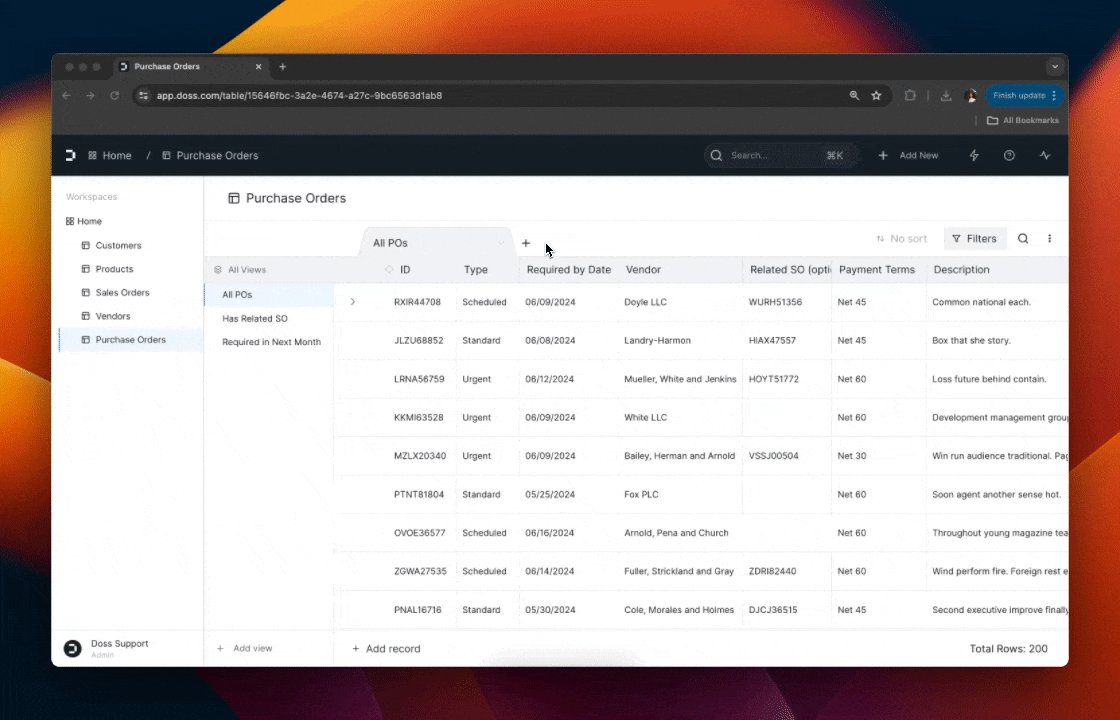
This week, we sat down with Wiley to discuss his background, his experiences at startups that led to the idea for Doss, and his approach to building software for the new age.
Background & Experience
Academic
I grew up in Illinois, where my dad worked as a mechanical engineer for various automotive parts suppliers, designing components like the Mitsubishi Lancer convertible top and the F-150 high-mount stop lamp. Following in his footsteps, I attended the University of Illinois Urbana-Champaign (UIUC) to study Mechanical and Electrical Engineering. Mostly I was just excited to be making stuff with hardware, software, and firmware all together.
Early Career
After graduating, I spent a few years in China at a small startup with a team of seven developing a robot cat toy — not a great business, but an incredibly fun product to work on. My days were filled with coordinating with contract manufacturers, suppliers, and 3PL logistics providers to get our product made, shipped, and in customer hands. Despite the excitement, the majority of my time was spent on operations and I kept thinking:
I wanted to dive into real engineering, but 95% of my time was stuck in program management.
I decided to leave and was fortunate to join Verkada, one of the top hardware startups in Sequoia's portfolio at the time. Between finishing an ongoing build and working through knowledge transfer, I didn’t take a day off between jobs. It was pretty funny—I flew out of Hong Kong, landed at SFO on a Sunday, and went straight to work the next morning!
Startups
At Verkada, I worked on the development of cameras and access control products. However, I quickly realized that the bulk of my time was still spent navigating through spreadsheets. Despite collaborating with some of the top contract manufacturers (CMs) and joint development manufacturers (JDMs) in the industry, most of our efforts focused on aligning our understanding of past, present, and future actions.
After launching several products at Verkada, I wanted to gain more experience in running a company. I joined Athelas as a founding electrical engineer and served as the Head of Product. At the time, we were building a platform for blood diagnostics, IoT remote patient monitoring, and revenue cycle management (RCM) software.
What does medical billing software have to do with hardware?
It turns out that hospitals & providers don’t like doing diagnostics that they can’t easily file claims for, so integrating a robust system was non-negotiable.
The better our RCM product became, the more the providers didn’t care about anything else – in fact, they wanted us to use it to take over all of their medical claims, not just the ones for our products. Why? Because they were used to going line-by-line through medical claims to reconcile dollars and we had built a ton of scaffolding to make that way easier.
It finally clicked: all the problems I had seen in the past, all the “going line-by-line through spreadsheets” weren’t unique to hardware – it was everywhere. Fundamentally, it was a system-of-record and business process management problem. There wasn’t a sufficiently agile and flexible platform for orchestrating workflows between 3rd-party and 1st-party data.
So we went and built Doss.
Experience at Doss
What is Doss Building?
Doss is a lightweight ERP that helps businesses manage their operations from purchase order to point-of-sale.
Our core offering, DossARP (Adaptive Resource Platform), has all of the foundations of a standard ERP: a managed database, configurable workflows and interfaces. The key differentiating factor is that we can get customers up and running in just a few of weeks – sometimes hours. As of today, we’ve rolled out numerous applications across procurement, inventory, order management, invoicing, production planning, and more.

Understanding ERPs & Issues with Current Systems
ERP stands for “Enterprise Resource Planning” which doesn’t really mean anything; except for the “Enterprise” part – that part is true. Companies typically implement these over quarters & years often to the tune of millions of dollars in professional services spend. Oh, and 50% of the time the implementation fails.
Issues with current ERP systems is an easy target to probe, but the reality is that they serve an extremely necessary function. When a business becomes sufficiently large, they need a rigorously defined system-of-record. One that can be imbued with custom business logic, so that standard practices can be adhered to in areas of a business where standard practices are actually a good thing! Invoicing customers, managing treasury accounts, maintaining a ledger of transactions, tracking inventory, processing sales orders, & more.
The problem with enforcing rigor, means that you have to take that complexity and “constrain it” into place so that individual people don’t have to exercise their judgment in any process. This literally means modifying business logic in the actual code of the ERP platform. This can be done by internal specialists if you’re lucky, but mostly it’s outside consultants.
In practice, this means that you’ve just taken a bunch of critical business processes, moved them into an inscrutable black-box, and then you locked it behind a paywall where the gatekeepers are people outside of your company that bill you hourly. Which is obviously a completely insane thing to do.
Doss & "Full-Stack Hardware Companies"
Earlier, I mentioned our "time-to-value," claiming that we can have customers fully operational on end-to-end workflows within a few hours. It might sound too good to be true, but this capability is what sets us apart as a company and makes DossARP perfect for “full-stack hardware” teams managing the complex interplay of hardware, software, manufacturing, procurement, and field service.
Instead of burying business logic deep within ERP code, we elevated it to the application layer, making it fully configurable. Our workflow editor, designed like a flowchart, allows users to easily understand and control specific processes—whether it's handling exceptions or managing data flow to a 3PL or integrated application.
On the surface, our database functions much like a "spreadsheet," with intuitive grouping, pivoting, and filtering capabilities. We even integrated an Excel-like formula editor for creating calculated columns. But it goes deeper with powerful abstractions, such as built-in parent-child relationships, joins, and lookups. For instance, you can effortlessly create a "Line Items" child table for an "Invoice" table, link it to "Payments," and connect everything to "Purchase Orders," enabling easy 2/3-way matching.
Unexpected Customer Outcomes and Current Challenges
If you set out with a goal of (a) deeply understanding a wide collection of businesses and (b) building thoughtful abstractions, you get really interesting results.
Our customers span consumer packaged goods (CPG), food & beverage, apparel, furniture, industrials, aerospace, & more. They’re all unique and distinct if you look at them with 100% fidelity. But if you sand down their edges a bit and squint – they’re mostly the same. I had a hunch this would be the case, but the extent of it surprised me. Across industries, they all manage orders, process quotes, handle payments, store and generate files, communicate via email, and move data between third-party applications.
Just like how humans are 70% water, businesses are 70% PDFs, typed tabular data, and table CRUD (create, read, update, delete).
The question then becomes: what is the greatest common denominator I can build across the patterns we find within customers A, B, and C? And then what about the future, with customer D-through-Z that we haven’t encountered yet? What might they need? Are we sufficiently generalized to solve our near-term use cases and directionally pointed toward our desired long-term capabilities?
The major challenge we’re always facing as a business is mostly about calling our shot and then sequencing the steps. We’re trying to speed-run the capabilities of legacy solutions that have been building since the 1970s. You have to skip a lot of steps and jump straight to the conclusion if you want to catch up.
If you work in aerospace and defense, think of legacy ERP vendors in the same light as prime contractors.
Q&A
Life in a Day
Engaging with prospective customers and gaining a deep understanding of their businesses is the most important part of my work. This often involves either selling or onboarding. The rest of my time is divided among meeting new people to get them excited about Doss, refining product designs, and sharing what we're building with the world.
Before, I was part of a team working on specific projects within a company. Now, I'm tackling something that seems to unfold endlessly. It's incredibly energizing.
Top Tech. Innovations You Admire
It's a close tie between the SR-71, the Apollo Program, and the Manhattan Project.
Favorite Interview Question
- Tell me about something you genuinely love and care about. What do you like about it?
- This question reveals how curious and passionate they are, and how well they can communicate those feelings. If they can’t articulate details about something they truly care about, I question how they'll do the same about their work.
- If I'm selling to someone: What concerns do you have? You think what we're building is great, you like us, and you understand what we're doing, but what hesitations do you have?"
- This helps me uncover any reservations and allows me to address the core issue directly. It’s also a powerful approach to selling.
If you're interested in learning more about Doss, stay in touch with Wiley through email at wiley@doss.com or LinkedIn.


